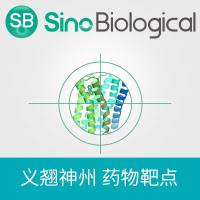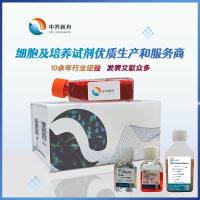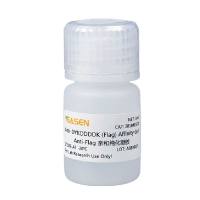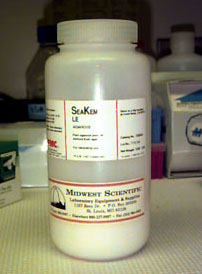Blue Native Gel Electrophoresis
互联网
Blue Native Gel Electrophoresis
Stock solutions
49.5%T, 3%C Acrylamide 24 g acrylamide, 0.75 g bisacrylamide / 50 ml H2O Store at RT
3 x Gel buffer 150 mM BisTris-HCl, 1.5 M 6-amino-caproic acid, pH 7.0 Adjust pH to 7.0 with HCl at 4°C Store at 4°C
75% (w/v) Glycerol Store at 4°C
10 x Cathode buffer 0.5 M Tricine, 150 mM BisTris No need to adjust pH Store at 4°C
5 x Anode buffer 0.25 M BisTris-HCl, pH 7.0 Adjust pH to 7.0 with HCl at 4°C Store at 4°C
2 x BisTrisACA 200 mM BisTris-HCl, 1 M 6-amino-caproic acid, pH 7.0 Adjust pH to 7.0 with HCl at 4°C Store at 4°C
50BTH40G 50 mM BisTris-HCl, 40% (w/v) Glycerol, pH 7.0 Adjust pH to 7.0 with HCl at 4°C Store at 4°C
Working solutions
1xCathode (-dye), 1x Anode buffer Store at 4°C
1xCathode+dye 0.01% Serva G in 1xCathode buffer
It takes a while to dissolve ServaG. Store at 4°C
BN-sample buffer
Serva G
50 mg
2 x BisTrisACA
500 ul
75% Sucrose
400 ul
H2O
100 ul
Store at -20°C
Solubilization buffer
50BTH40G
100 ul
10% Detergent
40 ul
H2O
60 ul
Detergent: TX-100, dodecyl-maltoside, digitonin or SDS
Water soluble digitonin should be used.
If you don’t get water-soluble digitonin, purify as described in Mori et al. (1999) J Cell Biol. 146, 45-55. We've also tried 2X crystalized digitonin with essentially the same results.
Note: the original method uses ACA in the solubilization buffer.
5-13.5% gradient blue native gel
Mini gel with 0.75 mm spacer
Sample (4%) for 2 gels
Separation (5%)
Separation (13.5%)
49.5% Acrylamide
0.242 ml
0.212 ml
0.573 ml
3 x Gel buffer
1.0 ml
0.7 ml
0.7 ml
75% Glycerol
0
0.14 ml
0.56 ml
H2O
1.72 ml
1.028 ml
0.247 ml
TEMED
6 ul
2 ul
2 ul
5% AP
Pour into a gradient maker
32 ul
11 ul
1.88 ml
11 ul
1.8 ml
Total
3.0 ml
2.1 ml
2.1 ml
Use mini alumina and glass plates
Sample gel height should be ~0.7 cm
Make gel one day before use and store at 4°C
Sample preparation
Wash thylakoids with 0.33 M Sorbitol, 50 mM BisTris-HCl, pH 7.0 Resuspend in 25 mM BisTris-HCl, 20% Glycerol, pH 7.0 Adjust [chl] to 2.0 mg/ml (or resuspend thylakoids in the resuspension buffer to 2.0 mg chl/ml) Add one volume of solubilization buffer, gently vortexing after each drop Agitate for 30 min (DM, TX-100), 30-60 min (Digitonin) at 0 to 4°C Spin at ~100,000 g for 30 min Transfer the supernatant to a new tube Add 1/10 vol of BN sample buffer Mix gently Load 5.5 ul onto BN-gel
Protein standard
Apoferritin +BSA
β-amylase +β-lactoglobulin
5 mg/ml protein stock
7.5 ul each
10.0 ul (amylase) 5.0 ul (lactoglobuli
Digitonin Solubilization buffer
15.0 ul
15.0 ul
BN-sample buffer
3.0 ul
3.0 ul
Protein stocks in 20% glycerol, 25 mM BisTrsi-HCl, pH7.0
Mix gently Load 5.5 ul
Protein marker
Mr (kDa)
Ferritin
880, 440
β-amylase
200
BSA
132, 66
β-lactoglobulin
35
Thyroglobulin (670kD) migrates at position close to ferritin dimer (880kD).
Electrophoresis
We use a Mighty Small Hoefer setup with a cooling core. Set a BN gel in a unit connected to a cooling circulator (2-4 C°C in the cathode tank) Load samples Run at constant voltage of 100-200 V, 3-6 hrs.
For immunoblotting or fluorography:
Exchange the cathode buffer (+dye) to cathode buffer lacking the dye after top 1/2 ~2/3 of the gel is covered with dye; then run until the free dye has run off of the bottom of the gel (~2 hrs). The gel should look like this:
For convenience, I put the power supply on a timer when I change to dye-minus cathode buffer. The power supply turns off at the end of the run, but the cooling circulator remains on and the gel stays
cold until the next morning, when it can be further processed.
Immunoblotting
Transfer buffer 25 mM Tris, 192 mM Glycine, 20% Methanol Use room temperature transfer buffer to kill peroxidase-like activities.
Incubate BN-gel in 0.1% SDS, Transfer buffer for ~10 min at RT 0.5 ml 10% SDS + 50 ml Transfer buffer Assemble blotting sandwich with PVDF membrane PVDF membrane must be wet in methanol before equilibration in transfer buffer Set in a blotter and run at constant voltage of 50 V for 45 min. - no ice in the chamber. Stain the blot with 0.1% PonceauS, 5% acetic acid It’s a little hard to see marker proteins. Destain with 20% MeOH, 7% acetic acid overnight to improve antibody binding. (I've been skipping any staining and destaining steps; KC.)
Treat the blot like ordinary immunoblotting
Fluorography
Treat with DMSO and then PPO/DMSO like an SDS-gel. (It's a little hard to see the MW stds of gels treated this way; I can see the orange ferritin bands and BSA monomer. Hiroki stains and detains his gels before PPO/DMSO to see the markers. I don't stain in order to avoid color quenching; KC)
2-Dimensional Analysis
The BN-gel is run as described above on a 0.75 mm thick gel. The lane of interest is sliced out with a razor blade and then incubated in SDS
sample buffer containing 2.5% mercaptoethanol for 10 min. at room temp. or 25°C. The slice is then placed on top of a 1 mm SDS-PAGE gel. We use a BioRad minigel apparatus for this. The stacking gel is poured with a comb that is mostly flat across but has a tooth on one side for mol. weight markers, etc. We've tried sealing with agarose or acrylamide, but it seems to work fine without any sealant. The 0.75 mm gel slice slides nicely onto the 1 mm stacking gel without a lot of pushing and tearing. We always use fresh gel slices (no freezing).











